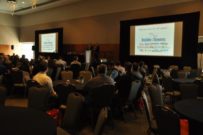Second Annual STAC Conference, Inside Towers Managing Editor Jim Fryer and Clay Parchewsky of WesTower and Co-Chair of the STAC Steering Committee
STAC (Structure, Tower & Antenna Council) was formed in 2015, following a year-long collaborative effort by nine companies – three wireless telecommunications service providers, three engineering firms and three communications construction companies. The motivation for forming STAC was to develop an industry-wide forum to identify and promote safe work practices for all personnel involved and educate the industry about consistent standards, policies and best practices with communications towers and related industry infrastructure. In short, give the industry a voice in Canada.
Only fourteen months and 73 member companies later, STAC is now hosting a packed and enthusiastic conference on the Canadian side of Niagara Falls. To those who have worked this market for many years, that voice is long overdue even though the Canadian Telecommunications Wireless Association (CTWA) has been around since before the days of cellular. But being a carrier-driven association, the CTWA had not focused on safety, although always a concern, as an issue industry-wide. The need prompted by the growth in deployment activity and the example in the U.S. set by NATE, helped get STAC started.
A cursory comparison of the tower markets on both sides of the border has some stark and sometimes amusing differences. Since the carriers ‘Up North’ have maintained control of their tower inventories, by and large, the presence of ‘towercos’ is relatively small. Jerry Bezner, Director of Tower and Accessory Sales with Alliance Corp. said, “The Canadian carriers were not as ‘cash-strapped’ and more protective of their networks.” A more open approach to allowing co-location, thus maximizing profits on their properties, kept the carriers in the tower business Bezner told Inside Towers.
One difference between the two markets that should make Americans reassess their caloric intake can be seen in the standards of harness manufacturers serving both markets. The American harness has to withstand a higher stress load due to, ouch, the relative girth of U.S. tower workers…a difference of ninety pounds.
Liability also takes a different path in Canada with the transfer of responsibility ultimately falling on the shoulders of the employer, not the manufacturer should equipment failure occur. “The employer should have bought the right equipment,” said Herve Landreville, President of GRAVI-T ZERO. Landreville has been serving the Canadian tower sector in safety training for the past five years after having rigged Cirque du Soliel acrobats and various theatre productions. Although the tower crews perform to a much smaller audience, the focus on safety is still the same, said Landreville.
The STAC Conference closes today with a keynote address by CTWA President & CEO Robert Ghiz.
March 30, 2017






Reader Interactions